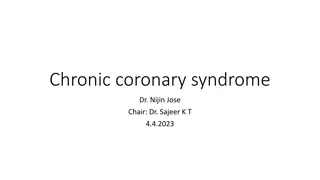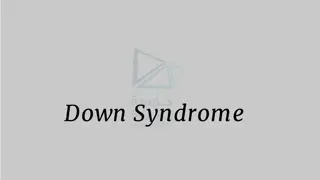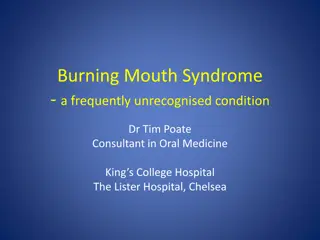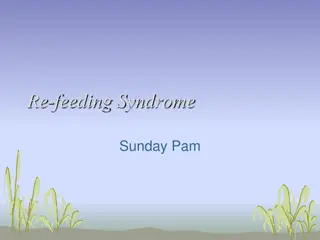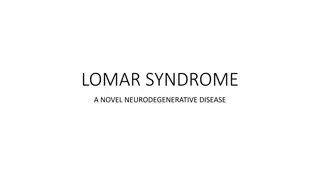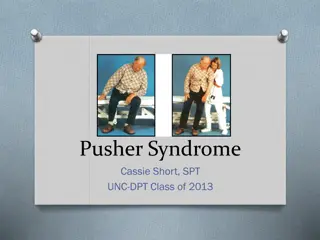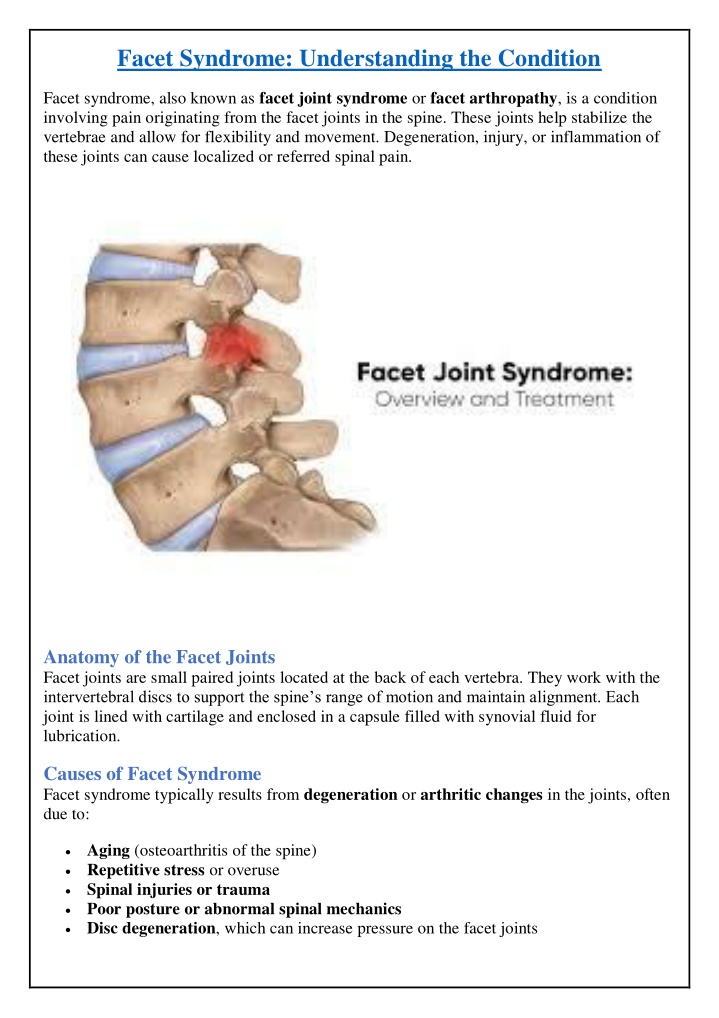
Facet Syndrome: Understanding the Condition
Facet syndrome, also known as facet joint syndrome or facet arthropathy, is a condition involving pain originating from the facet joints in the spine. These joints help stabilize the vertebrae and allow for flexibility and movement. Degeneration, inj
Download Presentation

Please find below an Image/Link to download the presentation.
The content on the website is provided AS IS for your information and personal use only. It may not be sold, licensed, or shared on other websites without obtaining consent from the author. If you encounter any issues during the download, it is possible that the publisher has removed the file from their server.
You are allowed to download the files provided on this website for personal or commercial use, subject to the condition that they are used lawfully. All files are the property of their respective owners.
The content on the website is provided AS IS for your information and personal use only. It may not be sold, licensed, or shared on other websites without obtaining consent from the author.
E N D
Presentation Transcript
Facet Syndrome: Understanding the Condition Facet syndrome, also known as facet joint syndrome or facet arthropathy, is a condition involving pain originating from the facet joints in the spine. These joints help stabilize the vertebrae and allow for flexibility and movement. Degeneration, injury, or inflammation of these joints can cause localized or referred spinal pain. Anatomy of the Facet Joints Facet joints are small paired joints located at the back of each vertebra. They work with the intervertebral discs to support the spine s range of motion and maintain alignment. Each joint is lined with cartilage and enclosed in a capsule filled with synovial fluid for lubrication. Causes of Facet Syndrome Facet syndrome typically results from degeneration or arthritic changes in the joints, often due to: Aging (osteoarthritis of the spine) Repetitive stress or overuse Spinal injuries or trauma Poor posture or abnormal spinal mechanics Disc degeneration, which can increase pressure on the facet joints
Symptoms Symptoms may vary depending on the region of the spine affected (cervical, thoracic, or lumbar), but commonly include: Localized pain and stiffness, especially after rest or in the morning Pain that worsens with extension or twisting movements Referred pain (e.g., into the buttocks or thighs if lumbar joints are involved) Muscle spasms around the spine Limited range of motion Diagnosis Facet syndrome is diagnosed through: 1.Medical history and physical exam to assess posture, mobility, and tenderness. 2.Imaging tests such as X-rays, CT scans, or MRI to visualize joint degeneration. 3.Diagnostic injections facet joint blocks or medial branch blocks using anesthetic to confirm the joint as the pain source. Treatment Options Non-Surgical Treatments: Medications NSAIDs, muscle relaxants, or pain relievers Physical therapy to improve posture, mobility, and core strength Chiropractic care including spinal manipulation in selected cases Heat/cold therapy to manage inflammation and discomfort Lifestyle changes weight loss, ergonomics, activity modification Interventional Treatments: Facet joint injections corticosteroids and anesthetics to reduce inflammation and pain Medial branch nerve blocks for temporary pain relief Radiofrequency ablation (RFA) uses heat to disable pain-carrying nerves, often effective for longer-term relief Surgical Treatments (rare): Surgery is considered only if conservative treatments fail and the condition significantly impairs function. Options may include spinal fusion or decompression procedures. Prognosis With appropriate treatment, many patients experience significant improvement or complete resolution of symptoms. However, because facet joint degeneration is often part of the natural aging process, long-term management may be necessary.
Prevention Maintain good posture and spinal alignment Engage in regular exercise, especially core strengthening Avoid prolonged sitting or poor lifting techniques Maintain a healthy weight to reduce spinal load Conclusion Facet syndrome is a common source of chronic spinal pain, especially in older adults. With accurate diagnosis and a tailored treatment plan, symptoms can often be effectively managed without surgery. Early intervention and lifestyle modifications are key to preventing progression and maintaining spinal health. Contact us :- Dr. Sarthak Kadakia | Best Spine Surgeon in Borivali | Spine Specialist in Mumbai Phone -9701549701 E-mail - drsarthakkadakia@gmail.com Website -https://drsarthakkadakiaspine.com/






